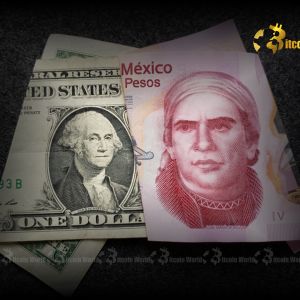USD/MXN Forecast: Bank of America’s Alarming Bet on Mexico’s Economic Downturn
8 min read
In the dynamic world of foreign exchange, institutional moves often signal deeper shifts in global economic currents. Recently, financial giant Bank of America (BofA) made headlines by initiating a significant long position on the USD/MXN currency pair. This strategic decision is not merely a trading play; it’s a profound statement on the deteriorating economic landscape of Mexico and carries significant implications for traders and investors worldwide. For those keenly observing the interplay between macroeconomic factors and currency valuations, BofA’s bold USD/MXN forecast demands immediate attention. What is Driving the USD/MXN Forecast? Bank of America’s decision to go long on USD/MXN is rooted in a meticulous assessment of Mexico’s current and projected economic trajectory. A ‘long’ position means BofA expects the US Dollar to strengthen against the Mexican Peso, indicating a belief that the Peso will depreciate. This move is a direct response to a confluence of factors that suggest a challenging period ahead for the Mexican economy. The core of their USD/MXN forecast hinges on several key observations: Weakening Growth Prospects: Economic indicators point towards a slowdown in Mexico’s GDP growth, influenced by both domestic and external pressures. This deceleration is a primary concern for investors. Persistent Inflationary Pressures: Despite efforts by Banxico (Mexico’s central bank), inflation remains a concern, potentially eroding purchasing power and investor confidence. High inflation often leads to currency depreciation. Fiscal Concerns: Government spending and potential deficits raise questions about long-term fiscal stability. Unsustainable fiscal policies can undermine a currency’s value. External Headwinds: Global economic uncertainties, particularly concerning the US economy, can significantly impact Mexico’s export-driven sectors and remittances. Mexico’s strong trade ties make it vulnerable to external shocks. Unpacking Mexico’s Economic Outlook: A Closer Look at the Challenges The narrative around Mexico’s economic outlook has shifted from cautious optimism to growing concern. Several macroeconomic indicators underscore the challenges that are prompting institutions like BofA to adjust their strategies. Understanding these factors is crucial for anyone involved in international finance or emerging markets. GDP Projections: Recent revisions by various analysts, including BofA, suggest a more subdued growth rate for Mexico in the coming quarters. This deceleration is partly attributed to tighter monetary policy aimed at curbing inflation, which in turn can stifle investment and consumption. Inflationary Environment: While Banxico has been proactive with interest rate hikes, inflation, particularly core inflation, has proven sticky. High inflation can reduce real wages, dampen consumer spending, and make it more expensive for businesses to operate, ultimately slowing economic activity. Investment Climate: Despite efforts to attract foreign direct investment (FDI), uncertainties related to policy decisions, rule of law, and energy sector reforms have at times deterred investors. A robust investment climate is vital for sustainable economic expansion. Trade Dynamics: Mexico’s strong trade ties with the United States mean that any slowdown in the US economy can have a direct, negative impact on Mexican exports. Furthermore, supply chain disruptions and geopolitical tensions continue to pose risks to global trade, affecting Mexico’s economic outlook significantly. Navigating the Forex Market Analysis: What This Means for Traders For currency traders, BofA’s long USD/MXN position offers a significant data point in their forex market analysis . This isn’t just an academic exercise; it’s a signal that could influence trading strategies across the board. When a major institution takes such a public stance, it often validates or challenges existing market sentiment. Increased Volatility: Expect potentially increased volatility in the USD/MXN pair as more traders react to this news and adjust their positions. Opportunities for short-term gains may arise, but so do risks, demanding careful risk management. Trend Confirmation: For those who were already bearish on the Mexican Peso, BofA’s move could serve as a confirmation of their existing biases, potentially leading to stronger conviction in their trades. This institutional backing can reinforce a trend. Risk Management: Traders should re-evaluate their exposure to MXN-denominated assets and consider hedging strategies if they have significant holdings. Understanding the drivers behind BofA’s move can help in crafting more resilient portfolios, as highlighted by forex market analysis . Technical vs. Fundamental: While technical analysis remains crucial, BofA’s fundamental call emphasizes the importance of macroeconomic factors in driving long-term currency trends. A comprehensive approach combining both technical and fundamental analysis will be key to successful trading. The Ripple Effect on Emerging Market Currency Dynamics Mexico’s economic health and the performance of the Peso are often bellwethers for broader trends in emerging market currency valuations. BofA’s bearish stance on the MXN could send ripples through other developing economies, especially those with similar economic structures or trade dependencies. Contagion Risk: A significant depreciation of the Mexican Peso could lead investors to re-evaluate their exposure to other emerging market currencies, particularly those in Latin America, potentially triggering capital outflows from these regions. This ‘flight to safety’ can impact multiple markets. Investor Sentiment: The confidence of institutional investors in emerging markets is delicate. News of a major bank betting against a prominent emerging market currency can erode this confidence, leading to a more risk-averse environment globally for emerging market currency assets. Interest Rate Implications: If the Peso continues to weaken significantly, Banxico might be compelled to intervene further, possibly through additional interest rate hikes, to stabilize the currency and combat imported inflation. This could have broader implications for monetary policy in other emerging economies facing similar pressures. Diversification Strategy: Investors looking at emerging markets might consider diversifying their currency exposure or shifting towards more resilient economies within the emerging market basket to mitigate concentrated risks. Bank of America USDMXN Strategy: A Closer Look at Their Conviction The decision by Bank of America USDMXN desk to initiate a long position is not taken lightly. It reflects a high degree of conviction based on their proprietary models, research, and expert analysis. This strategy suggests they anticipate a sustained period of Peso weakness, rather than just a temporary fluctuation. To understand the depth of their conviction, consider the following: Comprehensive Data Analysis: BofA likely synthesizes a vast array of economic data, including inflation rates, interest rate differentials, trade balances, fiscal policies, and political stability, to arrive at their conclusion regarding the Bank of America USDMXN position. Risk-Reward Assessment: Despite the inherent risks in any currency trade, BofA has identified a favorable risk-reward profile for this particular position, suggesting they see significant potential for the Peso to depreciate further, outweighing the potential downsides. Long-Term Horizon: While specific timeframes aren’t always public, institutional positions often imply a medium to long-term outlook, indicating that the anticipated economic challenges for Mexico are not expected to be fleeting. Client Advisory: Such a prominent move by BofA also serves as an implicit advisory to their institutional clients, signaling potential shifts in investment recommendations and portfolio allocations, guiding their decisions based on the Bank of America USDMXN outlook. Table: Key Factors Influencing USD/MXN Movement (BofA’s Perspective) Factor Impact on MXN (BofA’s View) Rationale Economic Growth Negative Slowdown reduces demand, lowers investment appeal. Inflation Negative Erodes purchasing power, higher cost of living. Interest Rate Policy Mixed (Supports MXN, but growth concern overrides) Higher rates attract capital, but also stifle growth. Fiscal Policy Negative Potential deficits, spending concerns. Global Risk Sentiment Negative Flight to safety (USD) during uncertainty. US Economic Health Mixed (Strong US good for exports, but Fed hikes hurt) US slowdown impacts Mexican exports & remittances. Challenges and Risks for the USD/MXN Long Position While BofA’s position is based on solid analysis, no market prediction is without risk. Several factors could challenge their long USD/MXN bet: Unexpected Economic Recovery: A stronger-than-anticipated rebound in Mexico’s economy could invalidate the premise of Peso weakness, surprising the market. Aggressive Banxico Intervention: Mexico’s central bank could implement more drastic measures to support the Peso, such as direct market intervention or steeper rate hikes, directly counteracting depreciation. Global Shift in Risk Appetite: A sudden surge in global risk appetite could lead to capital inflows into emerging markets, strengthening the Peso as investors seek higher yields. Commodity Price Surge: As a significant oil producer, a sustained increase in crude oil prices could boost Mexico’s export revenues and strengthen the Peso, providing a natural hedge. Political Stability: Unexpected positive political developments or reforms could improve investor confidence, leading to capital inflows and Peso appreciation. Actionable Insights for Investors and Traders For those looking to navigate these turbulent waters, here are some actionable insights: Monitor Mexican Economic Data: Keep a close eye on GDP reports, inflation figures, industrial production, and trade balances. These will be key indicators of whether the outlook is indeed worsening or showing signs of recovery, impacting the USD/MXN forecast . Track Banxico’s Policy: Stay updated on Banxico’s monetary policy decisions and any statements regarding currency intervention. Their actions will directly impact the Peso’s strength. Assess Global Risk Sentiment: The USD often acts as a safe-haven currency. Shifts in global risk appetite (e.g., due to geopolitical events, major economic announcements) can significantly influence the USD/MXN pair. Consider Diversification: For investors with significant exposure to emerging markets, diversifying across different currencies or regions might be a prudent strategy to mitigate risks associated with specific economic downturns. Utilize Risk Management Tools: Employ stop-loss orders and appropriate position sizing to manage potential losses, especially given the increased volatility that might follow such institutional pronouncements in forex market analysis . Conclusion: What Does This Mean for the Future of the Peso? Bank of America’s initiation of a long USD/MXN position is a powerful indicator of mounting concerns over Mexico’s economic outlook . It underscores a belief that the Mexican Peso is likely to face sustained pressure in the coming period. While no forecast is infallible, the depth of analysis from a major financial institution like BofA provides a critical perspective for anyone invested in or trading emerging market currencies. This move highlights the interconnectedness of global finance, where macroeconomic challenges in one nation can trigger strategic shifts among major players, impacting currency markets worldwide. As the situation evolves, market participants will be keenly watching for further data confirming or contradicting BofA’s bold stance. The coming months will undoubtedly be crucial for the Peso, and by extension, for the broader landscape of emerging market currency performance. The implications extend beyond just currency traders; businesses engaged in international trade with Mexico, investors holding Mexican assets, and even individuals receiving remittances will feel the effects of a strengthening dollar against the peso. Staying informed and agile will be paramount in navigating these shifting economic currents, especially when considering the Bank of America USDMXN strategy. To learn more about the latest Forex market trends, explore our article on key developments shaping the US Dollar and Mexican Peso in global liquidity.

Source: Bitcoin World



